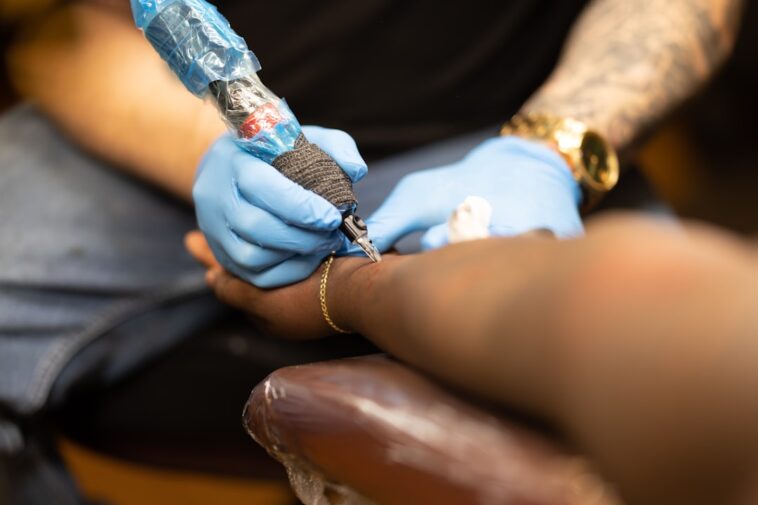So, you just got some fresh ink! Congrats! Getting a tattoo is super exciting, but it’s also important to understand the healing process. One of the most common questions people ask is: “How long does it take for a tattoo to heal?” The answer isn’t always straightforward, as healing times vary from person to person and depend on several factors.
Generally, the surface of a tattoo will appear healed within 2 to 3 weeks. However, the healing process isn’t just about the surface; it’s about what’s happening underneath the skin. The deeper layers can take anywhere from 2 to 6 months to fully heal. Think of it like a scraped knee. It might look okay after a couple of weeks, but it’s still a bit tender and sensitive for a while longer.
Factors Affecting Tattoo Healing Time
Several things can influence how quickly or slowly your tattoo heals. Knowing these factors can help you understand what to expect and how to optimize the healing process.
Tattoo Size and Placement
Larger tattoos naturally take longer to heal than smaller ones because there’s simply more area for your body to repair. Similarly, the location of your tattoo plays a big role. Areas with more blood flow, like your upper arms and calves, tend to heal faster. Areas with less blood flow or more friction, such as your feet, elbows, or inner thighs, might take longer.
Your Overall Health
Your immune system is your body’s superhero when it comes to healing. If you’re generally healthy, with a strong immune system, your tattoo will likely heal faster. Conditions that weaken your immune system, such as diabetes, autoimmune diseases, or even just a bad cold, can slow down the healing process. Lifestyle factors like stress, poor diet, and lack of sleep can also impact your immune function and, therefore, your healing time.
Aftercare Routine
This is HUGE! Proper aftercare is arguably the most important factor in determining how quickly and well your tattoo heals. Following your tattoo artist’s instructions closely can significantly speed up the process and prevent complications like infections. This includes keeping the tattoo clean, moisturized, and protected from the sun.
The Artist’s Skill and Technique
A skilled and experienced tattoo artist will know how deep to inject the ink and minimize trauma to the skin. Less trauma means faster healing. On the other hand, an inexperienced artist might go too deep or too shallow, which can lead to issues like blowouts (where the ink spreads under the skin) or scarring, both of which can prolong healing.
Stages of Tattoo Healing
Knowing what to expect during each stage of healing can help you understand if your tattoo is healing normally.
Week 1: Oozing and Redness
In the first few days, your tattoo will likely be red, swollen, and tender. It will also ooze plasma and excess ink. This is normal. Gently wash the area with mild, fragrance-free soap and pat it dry. Apply a thin layer of tattoo aftercare ointment recommended by your artist. Avoid bandages unless specifically instructed by your artist.
Week 2: Itching and Peeling
Around the second week, your tattoo will start to itch and peel, similar to a sunburn. This is a sign that the skin is regenerating. Resist the urge to scratch or pick at the flakes, as this can damage the tattoo and increase the risk of infection. Continue to moisturize regularly.
Weeks 3-4: Surface Healing
By weeks 3 and 4, the peeling should subside, and the surface of your tattoo will appear healed. The colors may look a bit dull at this stage, but don’t worry, they’ll become more vibrant as the deeper layers of skin heal.
Months 2-6: Deeper Healing
Even though the surface looks healed, the deeper layers of your skin are still recovering. During this time, continue to moisturize and protect your tattoo from the sun. You might notice some subtle changes in the tattoo’s appearance as the ink settles into the skin. The colors will become brighter, and the lines will become sharper.
Signs of Infection
It’s important to be aware of the signs of infection so you can seek medical attention if needed. Some common signs of an infected tattoo include:
- Excessive redness or swelling
- Pus or discharge
- Fever
- Increased pain or tenderness
- Red streaks radiating from the tattoo
If you experience any of these symptoms, contact your doctor or a dermatologist right away.
Tips for Faster Tattoo Healing
Want to give your tattoo the best chance of healing quickly and properly? Here are some tips:
- Follow your tattoo artist’s aftercare instructions carefully.
- Keep the tattoo clean by washing it gently with mild soap and water.
- Moisturize regularly with a fragrance-free lotion or ointment.
- Avoid sun exposure. If you must be in the sun, use a high SPF sunscreen.
- Wear loose-fitting clothing to avoid friction.
- Stay hydrated and eat a healthy diet.
- Avoid swimming, hot tubs, and baths until the tattoo is fully healed.
- Don’t pick or scratch at the tattoo.
Frequently Asked Questions
Can I exercise after getting a tattoo?
It’s best to avoid intense exercise for the first few days after getting a tattoo. Sweat can irritate the skin and increase the risk of infection. After a few days, you can gradually ease back into your workout routine, but be sure to keep the tattoo clean and dry.
Can I use Vaseline on my tattoo?
While Vaseline was once a common recommendation, many tattoo artists now advise against it. Vaseline is very thick and can trap moisture, which can create a breeding ground for bacteria. Lighter, breathable lotions or ointments are generally preferred.
Is it normal for my tattoo to itch?
Yes, itching is a normal part of the tattoo healing process. However, it’s important to resist the urge to scratch, as this can damage the tattoo and increase the risk of infection. Try gently patting the area instead.
My tattoo is raised in some areas. Is this normal?
Some slight raising of the tattoo, especially in the linework, can be normal, particularly during the initial healing stages. This is often due to the skin’s natural reaction to the trauma and the presence of ink. However, if the raising is excessive, accompanied by redness, pain, or pus, it could be a sign of infection or an allergic reaction, and you should consult a doctor.
In conclusion, while the surface of your tattoo might look healed in a few weeks, the complete healing process can take several months. By following proper aftercare instructions, maintaining a healthy lifestyle, and being patient, you can help ensure that your tattoo heals beautifully and lasts a lifetime. Listen to your tattoo artist, pay attention to your body, and enjoy your new ink!



GIPHY App Key not set. Please check settings